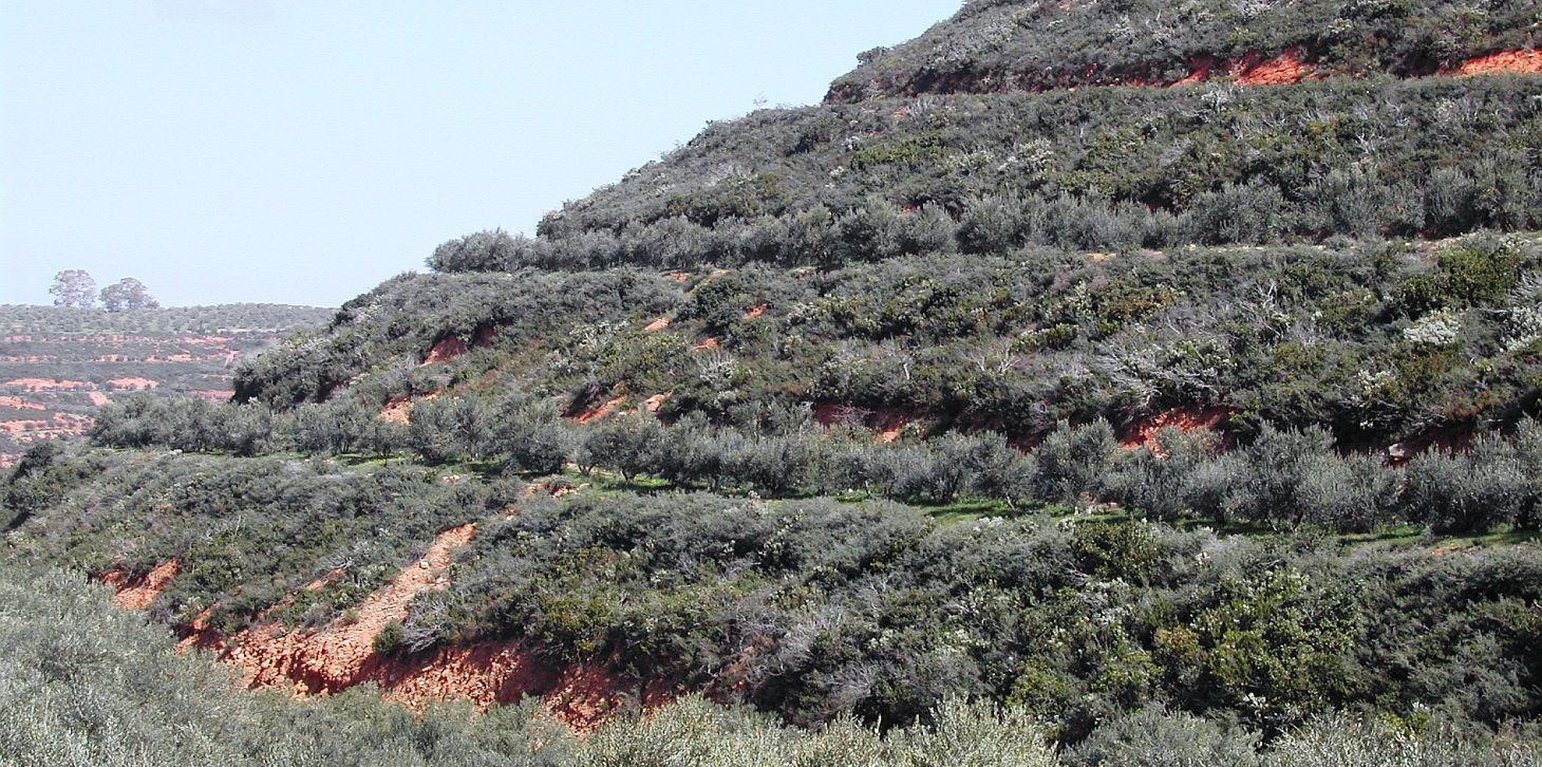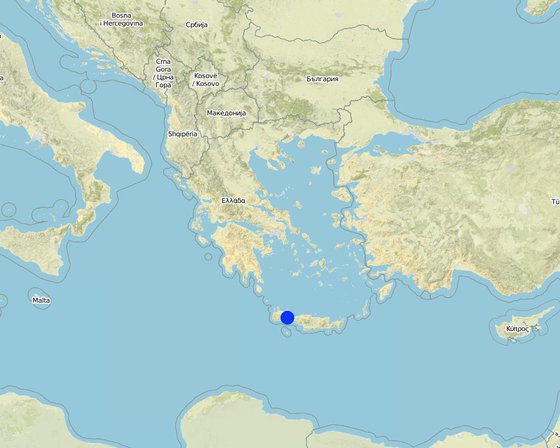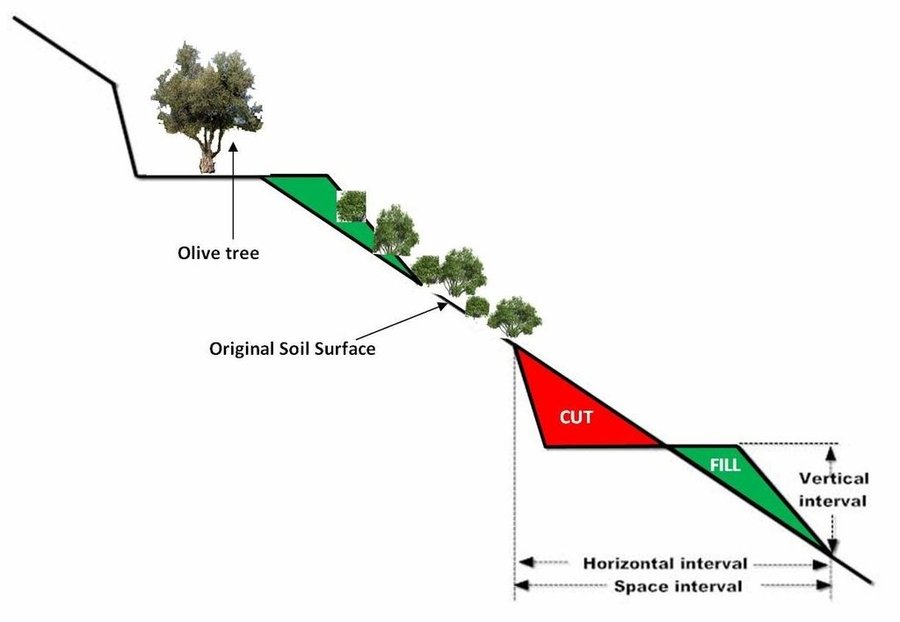



Bench terrace is the main type of terraces existing in the area of Chania. Land terracing is mainly found in the middle and upper zone of the study area and especially in steep slopes and in soils formed mainly in shale or conglomerates parent material. The land in which terraces have been constructed is estimated to 7.7% of the total area of Chania. Some bench terraces have been constructed recently in very steep slopes for cultivating the land.
Local agronomists recommend the construction of terraces as a measure for soil erosion protection in hilly areas.
The first step for construction of bench terrace is to clear the field of trash, dead furrows are filled in, and small ridges are levelled. The interval between terraces depends on soil characteristics and amount of rainfall. Usually, it is not recommended space interval narrower than 30 meters. Terrace system design usually begins with a technician evaluating the water regime of the field from observations, soil surveys, and other information. The next decision is whether waterways should follow natural draws or be constructed on new sites. The channel along the terrace for removing excess of runoff water is at least 30 to 45 cm deep and the maximum allowed gradient 0.4% for most soils to avoid serious erosion. Terrace layout begins from the highest point of the field. The vertical fall and slope gradient from the high point to the approximate site of the top terrace, usually 30 to 50 m downslope (depending on gradient), is determined with an engineering level. It is usually preferable to begin staking a terrace at the waterway and work up to the top end. Usually some stakes need to be reset to avoid short, sharp curves and to make field work parallel to the terrace easier. The first layout of a terrace system seldom achieves the most satisfactory design. Some unexpected topographical feature may show up and necessitate changing one or more terrace lines. The final terrace positions should be identified by plough furrows or other implement marks before construction begins. Conventional terraces can be built with bulldozers, motor patrol graders, carryall scrapers, elevating grader terracers, mould-board ploughs, disk tillers with 60 cm or larger disks, and with hand tools and baskets, headpans, or other carrying devices. Terraces rarely should be longer than 600 m. Terraces should not be longer than 375 m on already gullied land. Longer terraces need to be sub¬divided with an outlet provided for each segment. Terraces must be wide enough to accommodate the equipment that will be used in the field, generally not less than 4.5 m. The flatter these slopes are, the easier is to farm but the more expensive they are to build. Trees are usually planted in the upper part of the terrace. In modern terraced fields crop cultivation is fully mechanized. In such terraced fields all farm operations should carried out as nearly as parallel to the terrace as possible to minimize water and soil movement between terraces and to reduce damage to the terrace ridges. The most evident effect of tillage operations, after several years is the increase in the base width of the terrace. The best method of maintaining the shape of the terrace cross section and counteracting erosion from the inter-terraced area is by ploughing with a reversible mouldboard. In steep slopes is recommended to keep the natural vegetation in the part of the steep slope for soil erosion protection.

Lugar: Chania-Cete, Selinos province, Grecia
No. de sitios de Tecnología analizados:
Difusión de la Tecnología:
¿En un área de protección permanente?:
Fecha de la implementación: hace más de 50 años atrás (tradicional)
Tipo de introducción





| Especifique insumo | Unidad | Cantidad | Costos por unidad (Euro) | Costos totales por insumo (Euro) | % de los costos cubiertos por los usuarios de las tierras |
| Equipo | |||||
| machine use | ha | 1,0 | 1950,0 | 1950,0 | |
| Costos totales para establecer la Tecnología | 1'950.0 | ||||
| Costos totales para establecer la Tecnología en USD | 1'402.88 | ||||
| Especifique insumo | Unidad | Cantidad | Costos por unidad (Euro) | Costos totales por insumo (Euro) | % de los costos cubiertos por los usuarios de las tierras |
| Equipo | |||||
| machine use | ha | 1,0 | 60,0 | 60,0 | |
| Indique los costos totales para mantenecer la Tecnología | 60.0 | ||||
| Costos totales para mantener la Tecnología en USD | 43.17 | ||||
Cantidad antes de MST: 1200 kg/ha
Cantidad luego de MST: 1500 kg/ha
Cantidad antes de MST: 120 euro/ha
Cantidad luego de MST: 80 euro/ha
Cantidad antes de MST: 3600 euro/ha
Cantidad luego de MST: 4500 euro/ha
increase farmers income and reduction the off site effects
15% more water stored into the soil
75% reduction in runoff
10% increase in soil moisture
75% reduction in soil loss